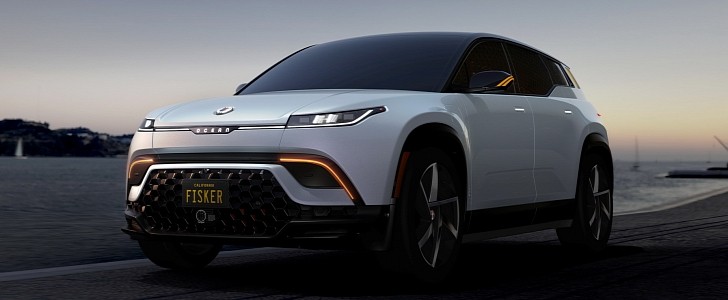Following its unveiling at the 2021 Los Angeles Auto Show in November of last year, the 2023 Fisker Ocean has now parked its fully electric behind in Las Vegas at the Consumer Electronics Show (CES 2022), in order to boast about its revolutionary Advanced Driver Assistance System.
What makes the Ocean’s ADAS tech special is the fact that it integrates four types of sensors. First, an industry-leading surround-view camera suite, followed by a camera-based driver monitoring system and ultrasonic technology. Then there’s the Digital Radar System, which Fisker expects will be first to market when the Ocean enters production in November of this year.
“Our asset-light, rapid-product-development business model enables us to bring these state-of-the-art active safety systems to market earlier than our competition,” said company CEO Henrik Fisker.
“Fisker Intelligent Pilot and Fisker Digital-Imaging combine reliable ADAS cameras with first-to-market 4D digital radars, giving owners industry-leading safety to go along with a $37,499 price for the Fisker Ocean Sport and over 350 miles of all-electric range for the top-of-the-line Fisker Ocean Extreme and Fisker Ocean One launch edition,” he added.
This Digital Radar technology uses five separate units positioned around the SUV to confirm and enhance everything the cameras see. The system also provides better perception in bad weather conditions, as well as when there’s excessive sun glare, which is why it’s considered superior to analog radar systems.
The Fisker Digital Radar can allegedly locate vehicles at 656 feet (200 meters) and pedestrians at 262 feet (80 meters). It can also distinguish its surroundings in environments of high light/dark contrast, such as inside tunnels, and can differentiate objects of varying sizes and speeds on highways. It can also separate objects from backgrounds and detect low-lying obstructions on the road.
As for the Ocean’s camera bundle, it consists of a front-facing 8-megapixel camera, delivering the highest resolution currently available in a vehicle, according to Fisker. Meanwhile, the 360-degree camera system enables base-level object detection.
If you’re planning on getting the $68,999 Fisker Ocean Extreme or the Fisker Ocean One, here’s what the Intelligent Pilot brings as standard: 360-degree Surround View cameras, Door Opening Warning, Park My Car system, Park Assist with Wheel Guard, Adaptive Drive Control, Automatic Emergency Braking, Reverse Collision Mitigation, Evasive Steering Assist, Integrated Drive Assist, Traffic Jam Assist, Driver Drowsiness and Attention Warning, Traffic Sign/Light Recognition, Front and Side Collision Warning, Lane Change Assist, Lane Keep Assist, Intelligent Speed Assist, Emergency Lane Departure Avoidance and Blind Spot Monitoring.
Fisker expects to offer even more safety features as over-the-air options either at the point of sale or afterwards.
“Our asset-light, rapid-product-development business model enables us to bring these state-of-the-art active safety systems to market earlier than our competition,” said company CEO Henrik Fisker.
“Fisker Intelligent Pilot and Fisker Digital-Imaging combine reliable ADAS cameras with first-to-market 4D digital radars, giving owners industry-leading safety to go along with a $37,499 price for the Fisker Ocean Sport and over 350 miles of all-electric range for the top-of-the-line Fisker Ocean Extreme and Fisker Ocean One launch edition,” he added.
This Digital Radar technology uses five separate units positioned around the SUV to confirm and enhance everything the cameras see. The system also provides better perception in bad weather conditions, as well as when there’s excessive sun glare, which is why it’s considered superior to analog radar systems.
The Fisker Digital Radar can allegedly locate vehicles at 656 feet (200 meters) and pedestrians at 262 feet (80 meters). It can also distinguish its surroundings in environments of high light/dark contrast, such as inside tunnels, and can differentiate objects of varying sizes and speeds on highways. It can also separate objects from backgrounds and detect low-lying obstructions on the road.
As for the Ocean’s camera bundle, it consists of a front-facing 8-megapixel camera, delivering the highest resolution currently available in a vehicle, according to Fisker. Meanwhile, the 360-degree camera system enables base-level object detection.
If you’re planning on getting the $68,999 Fisker Ocean Extreme or the Fisker Ocean One, here’s what the Intelligent Pilot brings as standard: 360-degree Surround View cameras, Door Opening Warning, Park My Car system, Park Assist with Wheel Guard, Adaptive Drive Control, Automatic Emergency Braking, Reverse Collision Mitigation, Evasive Steering Assist, Integrated Drive Assist, Traffic Jam Assist, Driver Drowsiness and Attention Warning, Traffic Sign/Light Recognition, Front and Side Collision Warning, Lane Change Assist, Lane Keep Assist, Intelligent Speed Assist, Emergency Lane Departure Avoidance and Blind Spot Monitoring.
Fisker expects to offer even more safety features as over-the-air options either at the point of sale or afterwards.







